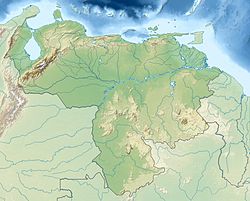Upuigma-tepui
| Upuigma-tepui | |
|---|---|
| Highest point | |
| Elevation | 2,100 m (6,900 ft)[1] |
| Coordinates | 05°05′10″N 61°57′23″W / 5.08611°N 61.95639°W |
| Geography | |
| Location | Bolívar, Venezuela |
Upuigma-tepui, also known as El Castillo, is a tepui in Bolívar state, Venezuela.[1] A relatively isolated peak, both it and nearby Angasima-tepui lie just south of the vast Chimantá Massif, from which they are separated by the Río Aparurén valley.[1] Upuigma-tepui is situated entirely within the bounds of Canaima National Park.[2]
The imposing peak of Upuigma-tepui has an elevation of around 2,100 metres (6,900 ft). Its highly uneven summit is dotted with numerous rock towers and deep crevasses which make it practically impossible to traverse. Summit vegetation is predominantly in the form of tepui scrub and dense stands of herbaceous plants. The mountain has a summit area of 0.63 km2 (0.24 sq mi) and an estimated slope area of 13 km2 (5.0 sq mi).[1]
The first documented people to climb Upuigma-tepui were John Arran, Ivan Calderon and Steve Backshall, in 2007. Upon reaching the summit, they discovered several previously unknown species of plants and animals.[3][4]
See also
[edit]References
[edit]- ^ a b c d Huber, O. (1995). Geographical and physical features. In: P.E. Berry, B.K. Holst & K. Yatskievych (eds.) Flora of the Venezuelan Guayana. Volume 1. Introduction. Missouri Botanical Garden Press, St. Louis. pp. 1–61.
- ^ (in Spanish) Torres, I.N. & D.D. Martín (November 2007). "Informe Final de la Evaluación del Parque Nacional Canaima, Venezuela, como Sitio de Patrimonio Natural de la Humanidad" (PDF). Mejorando Nuestra Herencia.
- ^ Conquering a virgin Venezuelan tepui. The Times, November 11, 2007.
- ^ Lost Land Of The Jaguar - The First Ascent of Upuigma Tepuis in Venezuela for BBC Natural History Unit. Adventure Camera.
Further reading
[edit]- (in Spanish) Brewer-Carías, C. (2010). El origen de los tepuyes: los hijos de las estrellas. Río Verde 3: 54–69.
- (in Spanish) La Cruz, L. (February–April 2010). Iván Calderon y su mundo vertical. Río Verde 1: 98–115.

